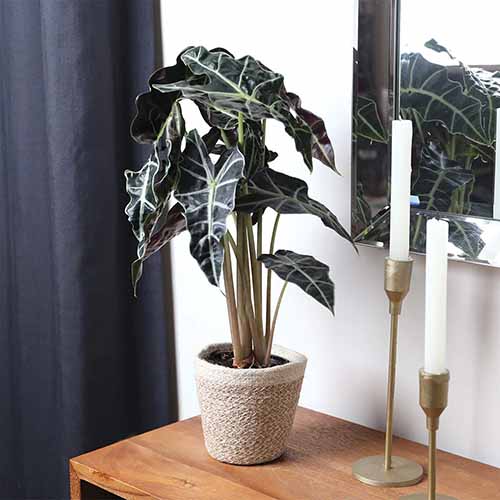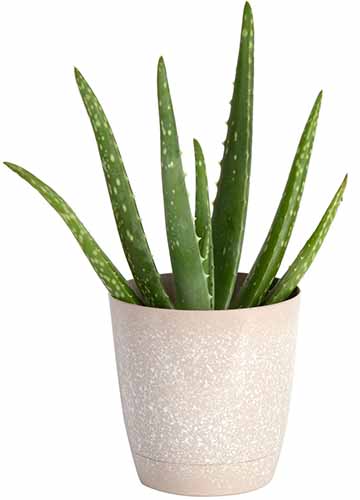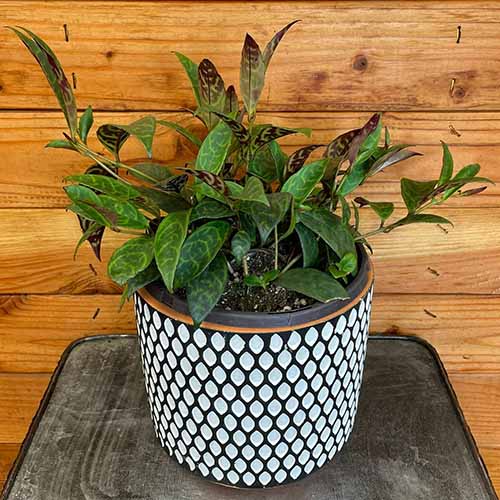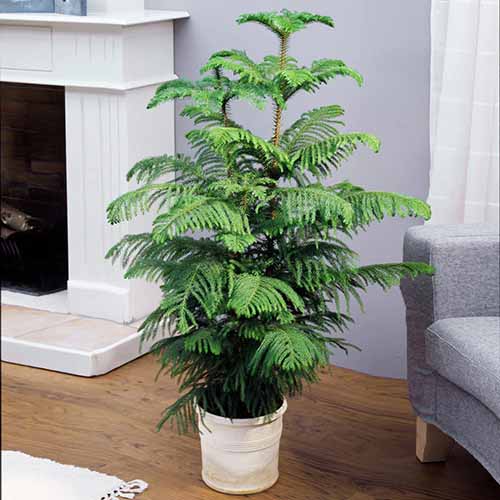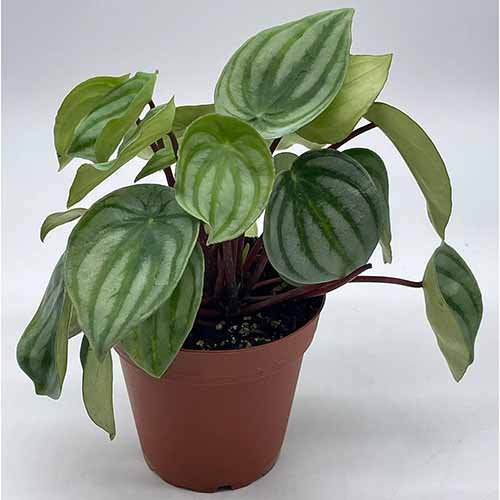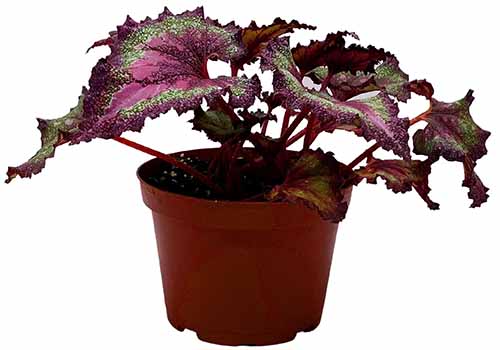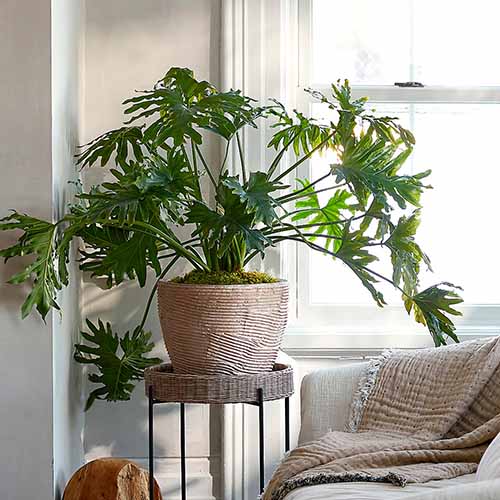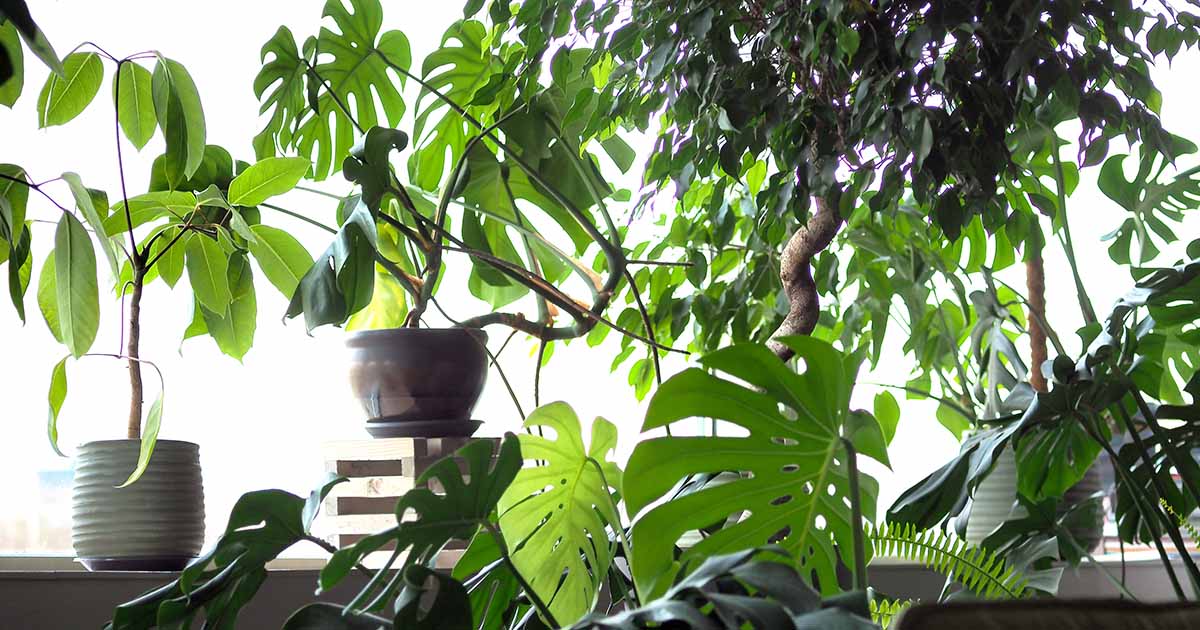
Another good reason for urgent repotting is if the container it’s growing in is much too large for the specimen.
Of course, even for species that tolerate being rootbound, there will come a time when you’ll eventually need to repot. I’ll provide some repotting tips for you at the end of the article.
But first you’ll want to learn what to look for as signs that you do indeed need to repot, so let’s learn more about these 17 houseplants that don’t mind being rootbound:
1. Alocasia
Our first selection is Alocasia, which doesn’t need frequent repotting.
Known for their supersized heart- or arrowhead-shaped leaves and high contrast coloration, alocasias (Alocasia spp.) are dramatic looking houseplants that will command your visual attention.
When it comes to care, alocasias need bright, indirect light and moderate watering.
These striking houseplants don’t mind being slightly rootbound and can keep growing in the same container until roots start emerging from drainage holes.
Once you witness those emerging roots, or the potting medium is drying out too fast, it’s time to repot.
‘Polly’ is a hybrid cultivar that has glossy, dark green leaves with purple undersides and ruffled edges, and contrasting white to light green leaf veins. It reaches two feet tall and wide at maturity.
Ready to introduce one of these into your home?
You’ll find live Alocasia ‘Polly’ specimens in decorative pots available for purchase from Fast Growing Trees.
Interested in learning more about growing and caring for alocasias? Read our article!
2. Aloe Vera
Next on our list is aloe vera, a succulent which thrives in rootbound conditions and shouldn’t be repotted often.
With long, tapering, fleshy leaves, Aloe vera is a staple in the DIY medicine chest because of the skin-soothing gel that is contained within its foliage.
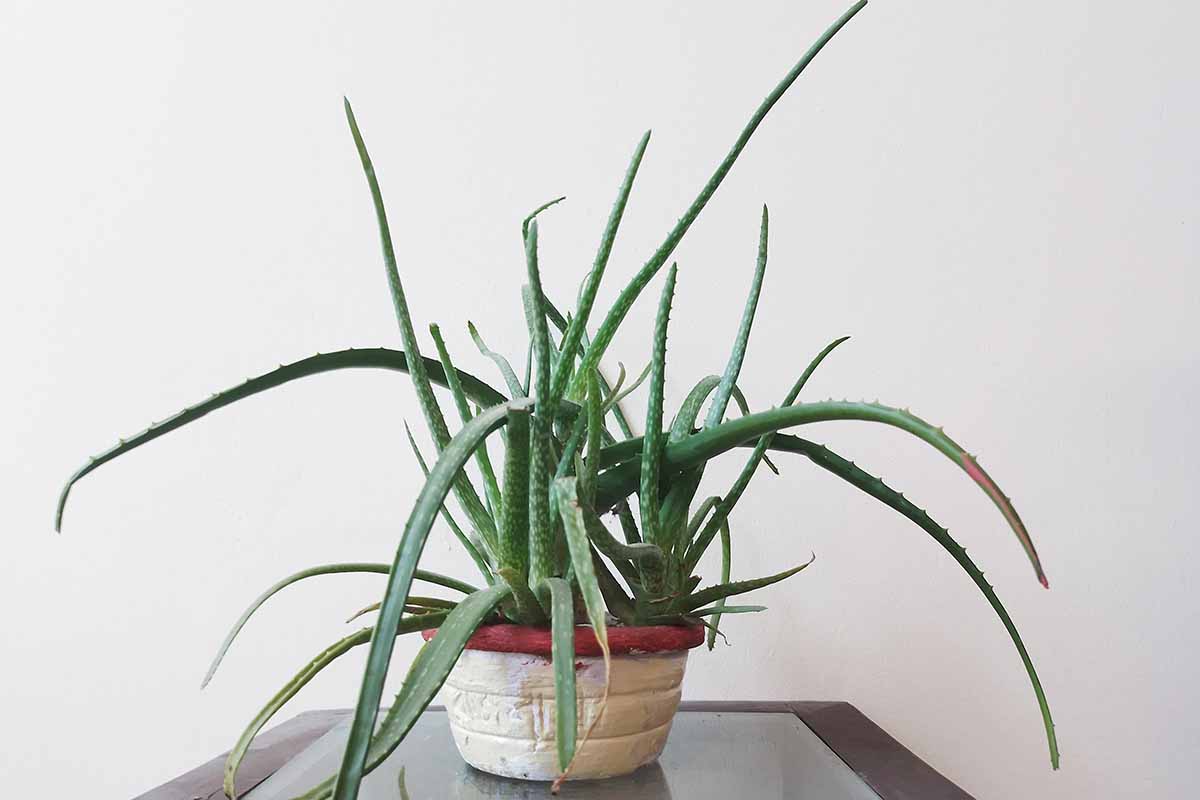
Aloe vera needs six hours of direct sunlight per day to thrive, and should be watered when the top two to three inches of growing medium are dry.
When it comes to repotting aloe vera, it will only need to be transplanted every few years.
You can let it go somewhat potbound, but it may be time to repot when roots are poking through the drainage holes, or the specimen is top heavy and prone to falling over.
Have you been living without one of these succulents?
Aloe Vera Plant in Decorative Pot
You can purchase live, seven-inch tall aloe vera plants in four-inch decorative pots from Costa Farms via Walmart.
If you’d like to learn more about growing and caring for aloe vera, check out our guide.
3. Amaryllis
Amaryllis doesn’t need to be repotted frequently, it prefers rootbound conditions.
You may think of the flower amaryllis (Hippeastrum spp.) as something to be discarded after it’s done blooming, but it can certainly be kept as a houseplant for the long term. They can actually live for decades!
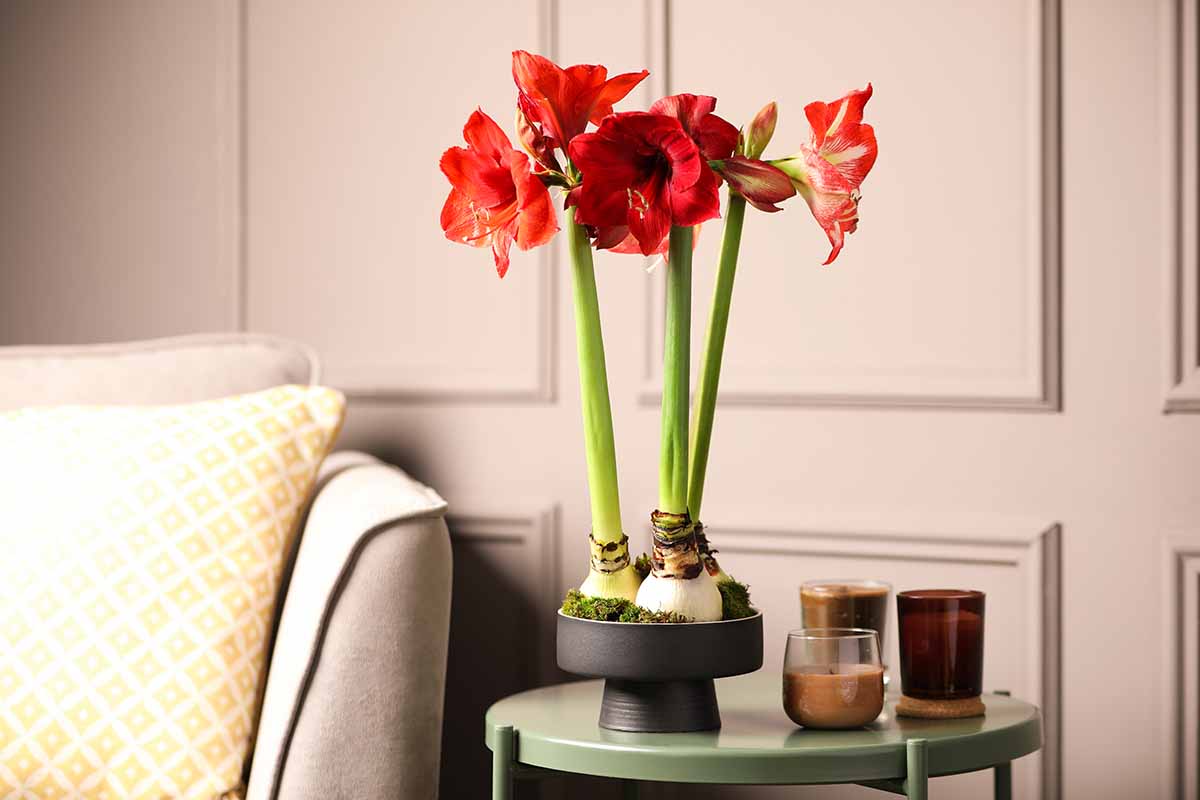
With showy blooms held on long, thick stems that emerge from large bulbs, amaryllis plants are right up there with poinsettias and Christmas cacti as “must have” living flora for the winter holidays.
Amaryllis thrives with six hours of direct sunlight per day and should be watered when the top few inches of the growing medium are dry.
Take care to use a houseplant watering can with a narrow spout to water only the growing medium, not the bulb.
Amaryllis bulbs should be grown snugly in their pots, and should only be repotted when the bulb becomes too large. Read our article on repotting amaryllis for more guidance.
‘Spartacus’ is a type of amaryllis with eye-catching, white and red blooms.
Looking for one of these to offer as a holiday gift? You’ll find them in kits, such as this one from the Daylily Nursery Store.
Kit With Live Amaryllis ‘Spartacus’
This amaryllis kit comes in a burlap gift bag and includes a ‘Spartacus’ amaryllis bulb, a decorative white ceramic pot, complete instructions, and growing medium.
You’ll find it at the Daylily Nursery Store via Amazon.
Find more tips for growing amaryllis in our complete guide.
4. Chinese Money Plant
This next selection, Chinese money plant, shouldn’t be repotted often. Instead, it should be allowed to grow in the same container until somewhat rootbound.
In the houseplant world, Chinese money plant (Pilea peperomiodes) is instantly recognizable – it has long, thin, arching stems, each of which bear a single, round green leaf, held like baubles on the plant.

These cute green pileas are nontoxic, so they make a good fit for households with kids and pets.
Good care for Chinese money plants includes offering bright, indirect sunlight, and watering when the soil is dry half way down the growing medium.
Related to watermelon pilea aka aluminum plants, Chinese money plants don’t like to be repotted, so it’s better to allow them to become somewhat rootbound before transferring to new containers – approximately every two years.
Whether you’re drawn to these pileas for their perky appearance or their Feng Shui symbolism of wealth, you can bring home one of your own!
You’ll find a live Chinese money plant in a four-inch nursery pot available for purchase from the California Tropicals Store via Amazon.
5. Christmas Cactus
This next selection, the well-loved Christmas cactus, doesn’t require frequent repottings and grows well when rootbound.
Known for their bright blooms that appear during the dark months of the year Christmas and other holiday cacti (Schlumbergera spp.) make excellent, easy-care houseplants.
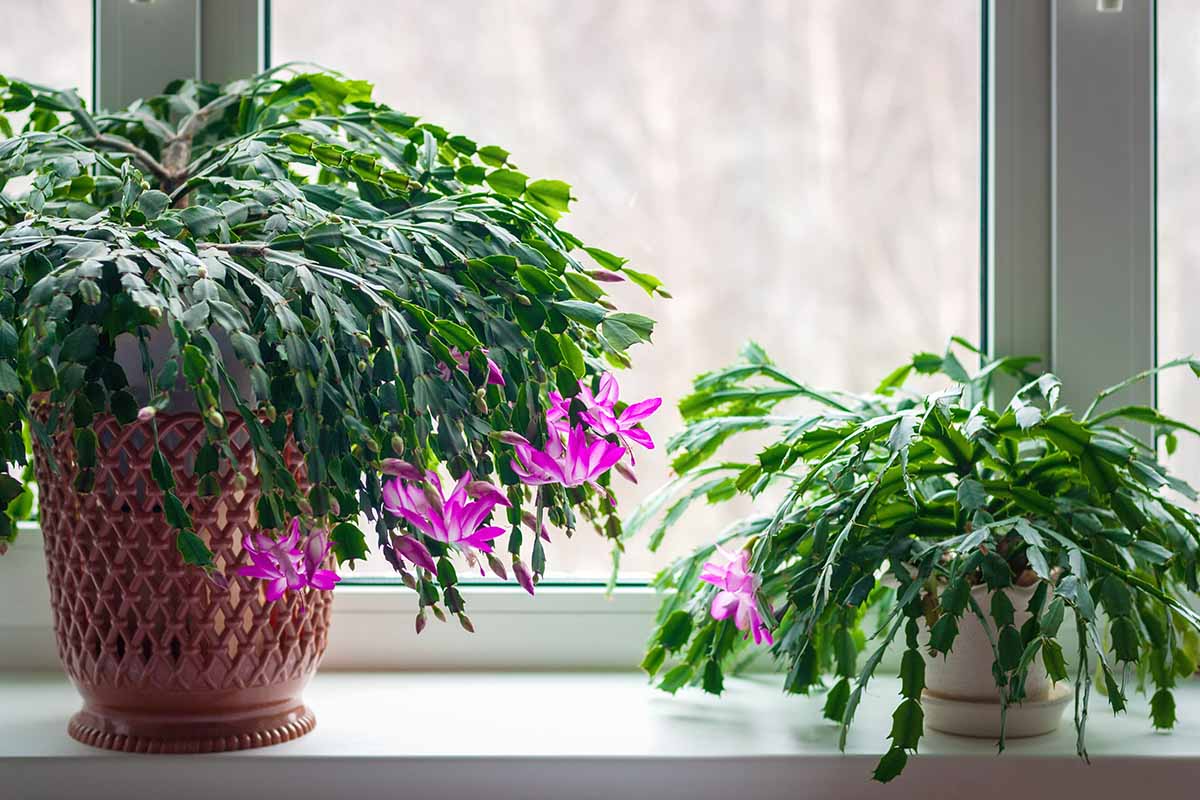
These pet- and kid-safe succulents have flattened, segmented stems that will bear flowers if conditions are right!
Provide Christmas cactus with bright, indirect light, and water when the top inch of the growing medium is dry.
As epiphytes, Christmas cacti don’t need a lot of growing medium for their root system and prefer to be slightly potbound. On average, holiday cacti should be repotted approximately every three years.
Want to add one of these to your home to liven up your holiday decor?
You can purchase live, 10-inch tall holiday cacti in decorative Christmas pot covers from the Costa Farms Store via Amazon.
Learn more about growing and caring for Christmas cactus in our complete guide.
6. Epiphyllum
Our next selection, epiphyllum, grows better when rootbound and only repotted infrequently.
Jungle cacti like their relative the Christmas cactus, Epiphyllum houseplants produce large, showy flowers, and have long, flattened, succulent stems.
Also known as orchid cacti, epiphyllums are safe for households with pets and young children.
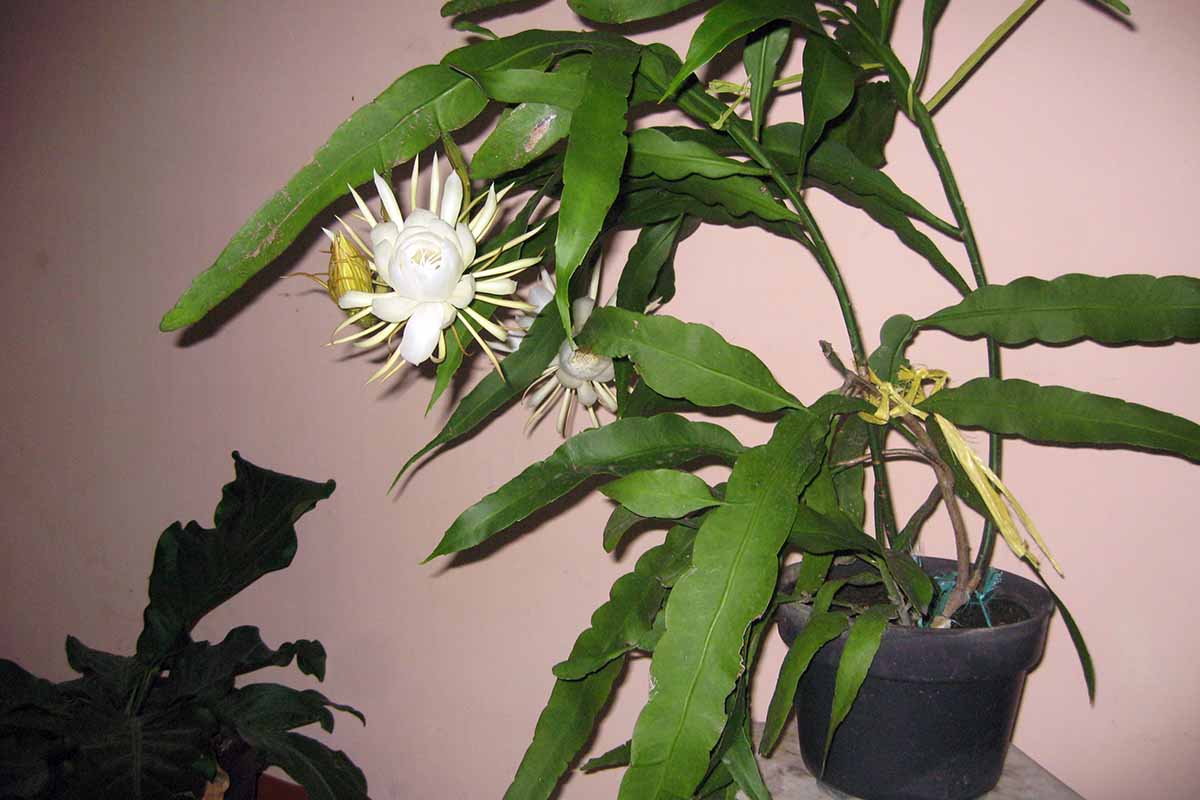
Indoors, epiphyllums should be grown primarily in bright, indirect light, though a couple of hours of direct sun in the morning will please these succulents too, as long as you habituate them to direct exposure gradually.
Water when the top third of the growing medium is dry.
As epiphytes, epiphyllums only need small pots compared to the massive amounts of foliage they produce, and they don’t mind being rootbound.
Plan on repotting every five to seven years or when the specimen becomes unstable in its pot.
E. hookeri subsp. guatemalense, also known as “curly Sue” or “curly locks” is an epiphyllum with twisting and curling stems.
I’m an avowed epiphyllum fanatic and this is one of my personal favorites.
Curly Sue Epiphyllum Orchid Cactus
Feel the same? You’ll find curly Sue epiphyllums in four-inch grower’s pots, available for purchase from the California Tropicals Store via Amazon.
Read our article to learn more about growing and caring for epiphyllums.
7. Jade Plant
Like many succulents, this next houseplant on our list also prefers to be rootbound rather than undergoing frequent repottings. I’m talking about jade plant.
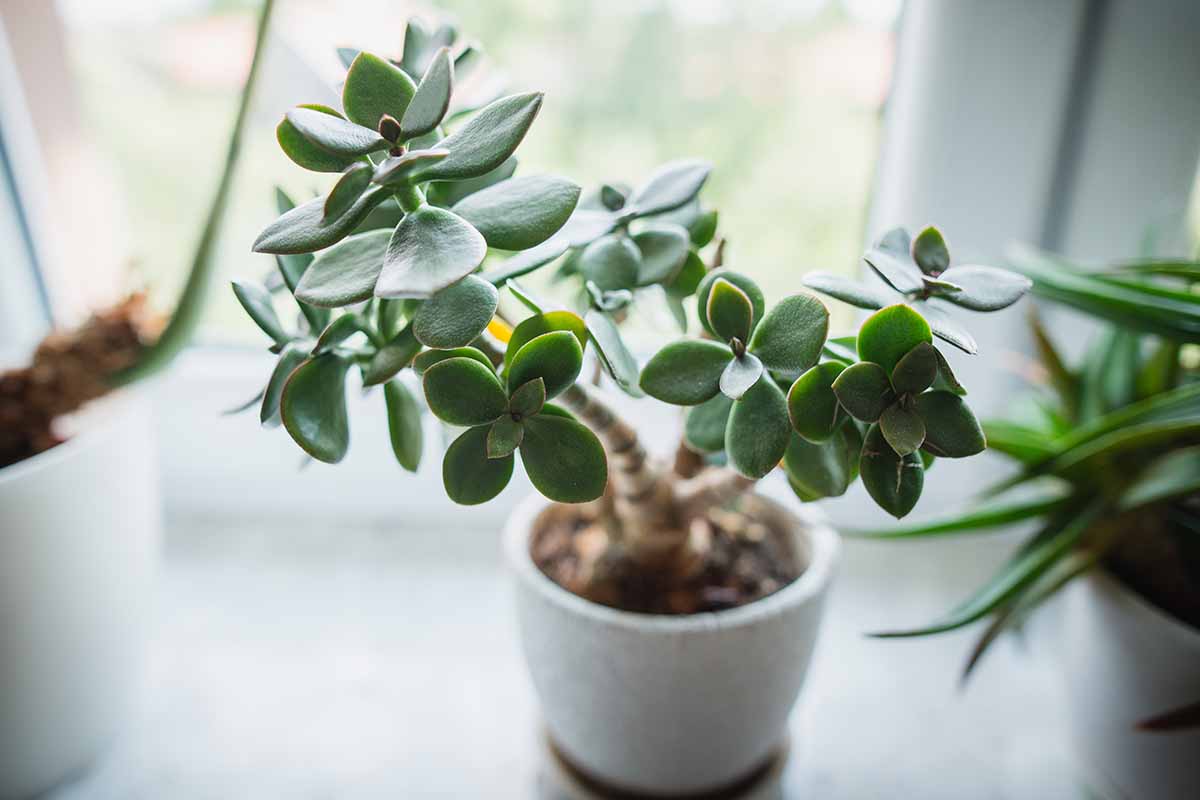
Jade plant (Crassula ovata) is a classic among succulent houseplants.
With egg-shaped, bright green leaves, an upright growth habit, and stems that turn woody, mature specimens often resemble miniature trees.
Jade plant grows best in direct sun for part of the day, complemented by bright, indirect light, and the soil should be allowed to dry out almost completely between waterings.
Don’t repot your jade plant until it is cracking its container or until its foliage is so heavy that it’s tipping over – approximately every four to five years.
Do your other succulents need a little jade tree to watch over them?
You can purchase live jade plants in four-inch grower’s pots from Hirt’s Garden Store via Amazon.
Want to learn more about growing jade plants indoors? Read our article!
8. Kalanchoe
Our next selection, kalanchoe, also favors rootbound conditions and shouldn’t be repotted often.
There are many different types of kalanchoes (Kalanchoe spp.) – but one thing these succulents have in common is that they don’t mind being snug in their containers.
Types of kalanchoe include panda plant (K. tomentosa) and mother of millions (K. delagoensis).

But perhaps one of the most well-known is K. blossfeldiana, commonly known as florist’s kalanchoe or flaming Katy, a houseplant popular for its brightly colored flowers and fleshy green foliage.
Grow kalanchoes in bright, indirect light, and water when the soil is dry three to four inches down.
As noted, these succulents don’t mind being rootbound, but look for roots emerging from drainage holes as a sign that it’s time to repot.
‘Calandiva Red’ is a kalanchoe cultivar that has dark green foliage and red, double blooms.
These make great gifts for that special someone – and maybe that special someone is yourself!
Whether it’s a gift to give or a gift to get, you’ll find live specimens of ‘Calandiva Red’ kalanchoe in four-and-a-half-inch nursery pots, available for purchase from the Succulents Box Store via Amazon.
Need a bit more guidance about how to care for kalanchoes? Read our guide.
9. Lipstick Vine
This next selection, lipstick vine, performs beautifully when allowed to become rootbound rather than repotting it frequently.
Nontoxic and related to African violets, lipstick vines (Aeschynanthus spp.) are epiphytes that have elliptical, green or variegated leaves, and reddish flowers that look like little tubes of lipstick.

Lipstick vines grow best in bright, indirect light. Allow the top few inches of soil to dry between waterings.
These houseplants don’t require frequent repotting, usually every two to three years is sufficient. In fact, they actually produce more flowers when somewhat potbound.
Black pagoda plant (A. longicaulis) is a type of lipstick vine with gorgeously patterned foliage and orangish-red flowers.
Do you have just the perfect spot for a hanging basket with lipstick vines trailing down?
You’ll find live black pagoda lipstick vines in six-inch nursery pots available for purchase from the Plant Farm via Walmart.
Want to learn more about growing this plant? Read our guide to caring for lipstick vine here.
10. Hoya
Speaking of flowers, keep this next selection rootbound rather than repotting it for a more floriferous hoya.
When picking a houseplant you often have to choose between either eye-catching foliage or showstopping blooms – but hoyas (Hoya spp.) give you both.
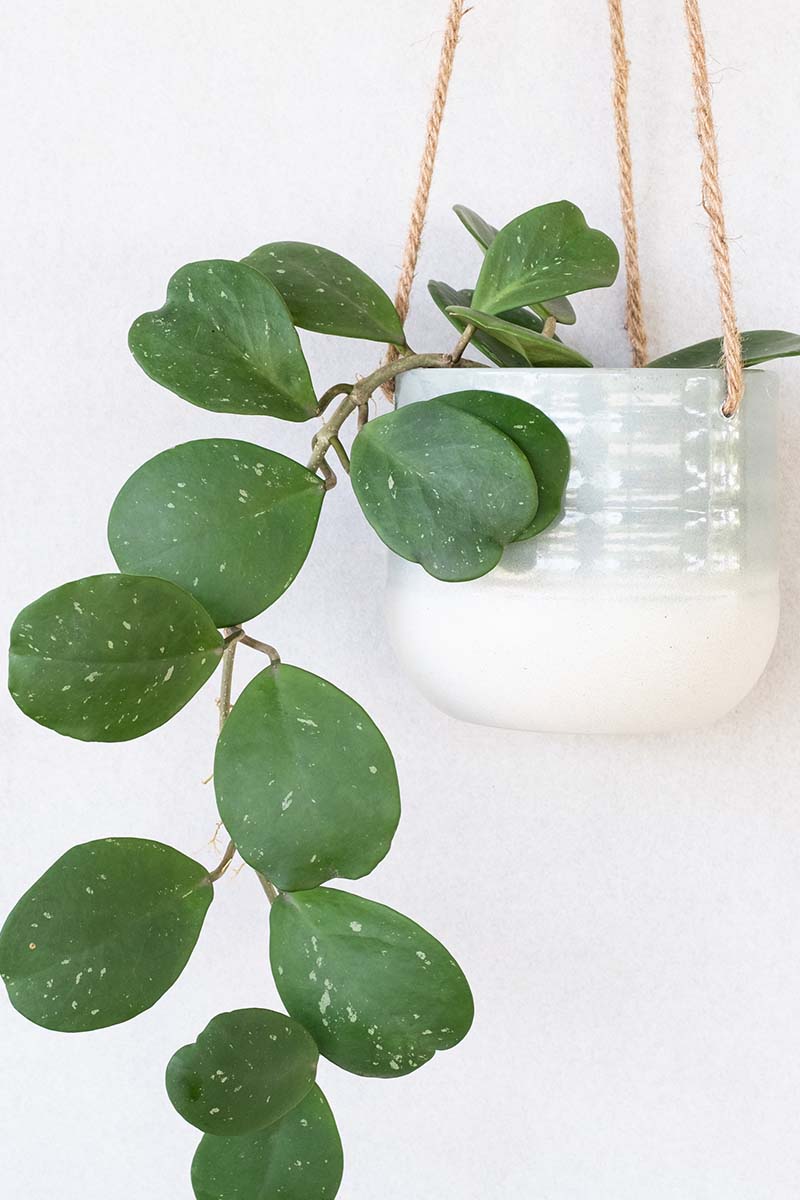
Safe for households with pets and small children, there are many, many different types of hoyas, and not all have the same light and water preferences.
But a good rule of thumb when you don’t know what kind you have is to offer bright, indirect light and to let the growing medium dry out completely between waterings.
Many Hoya species are epiphytes so they have small root systems, and they produce blooms more generously when rootbound. These are often grown in smallish pots compared to the large masses of foliage they produce, and only need to be repotted infrequently.
H. latifolia ‘Variegata’ (formerly known as H. macrophylla ‘Variegata’) is a beautiful hoya with large, thick, spear-shaped leaves, prominent veins, and outer variegation – that’s to say variegation on the margins of its leaves.
Need one of these to start off your hoya collection?
You can purchase live H. latifolia ‘Variegata’ specimens in four-inch nursery pots from the Green Escape via Amazon.
You can learn more about growing and caring for hoyas in our article.
11. Norfolk Island Pine
Our next selection, Norfolk Island pine, can be allowed to grow in rootbound conditions rather than repotting it to keep it from outgrowing our homes.
There aren’t many conifer trees that can grow happily indoors as houseplants, but Norfolk Island pines (Araucaria heterophylla) take to the indoor environment like superstars.
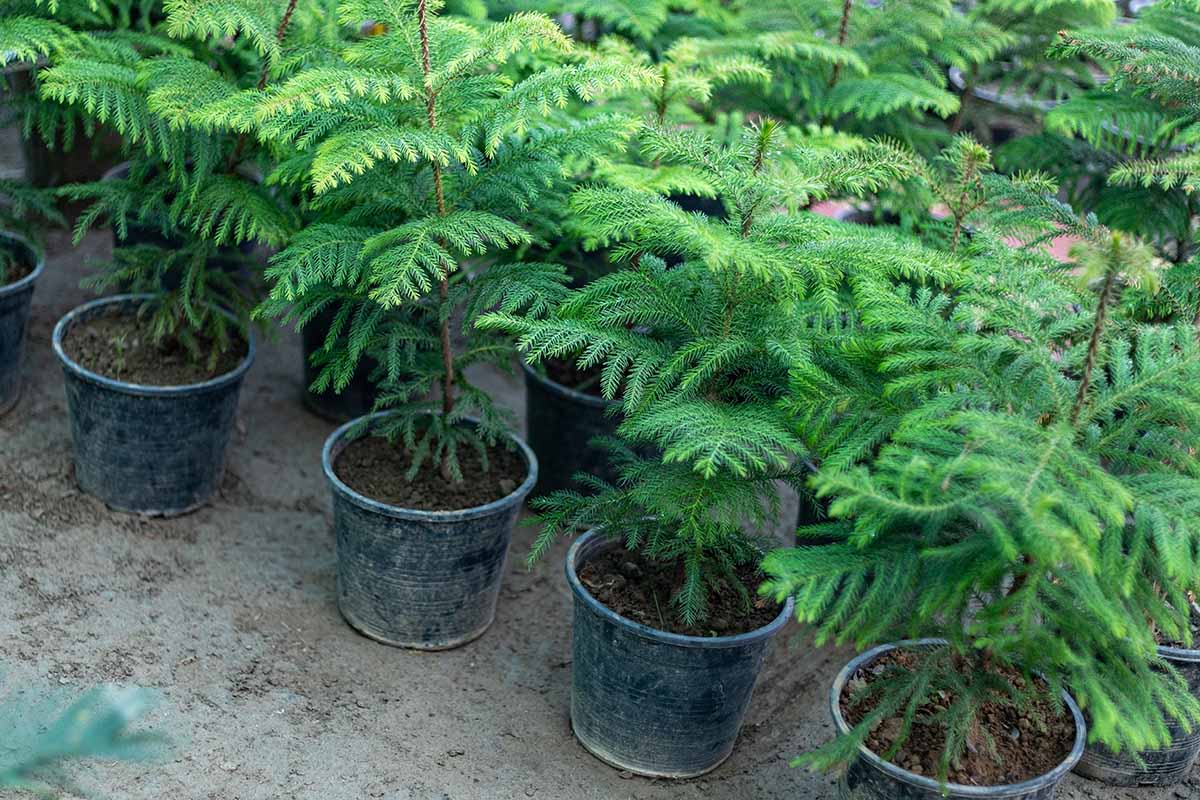
With green needles and softly drooping branches, these pyramid-shaped trees can serve as stand-in Christmas trees, or create a stately presence in a large space.
These nontoxic trees will thrive with a few hours of direct sunlight, supplemented with bright, indirect light. Water when the top inch of the growing medium is dry.
Repotting your Norfolk Island pine may be a chore you should put off – by repotting less often, it’s possible to keep this tree – which outdoors, can grow to 200 feet tall! – at a manageable size.
These conifers make gorgeous living Christmas trees that you can decorate – with lightweight baubles only, please! – year after year.
Ready to bring one of these home for some holiday cheer?
Live Norfolk Island pine trees in grower’s pots are available for purchase in an assortment of sizes from Fast Growing Trees.
Read our complete guide to growing and caring for Norfolk Island pines for more tips.
12. Peperomia
Our next selection, Peperomia, is a genus with many indoor-friendly species that grow well when rootbound, and don’t need frequent repotting.
Peperomia houseplants come in many shapes and sizes, but most of them are known for their attractive, fleshy foliage.
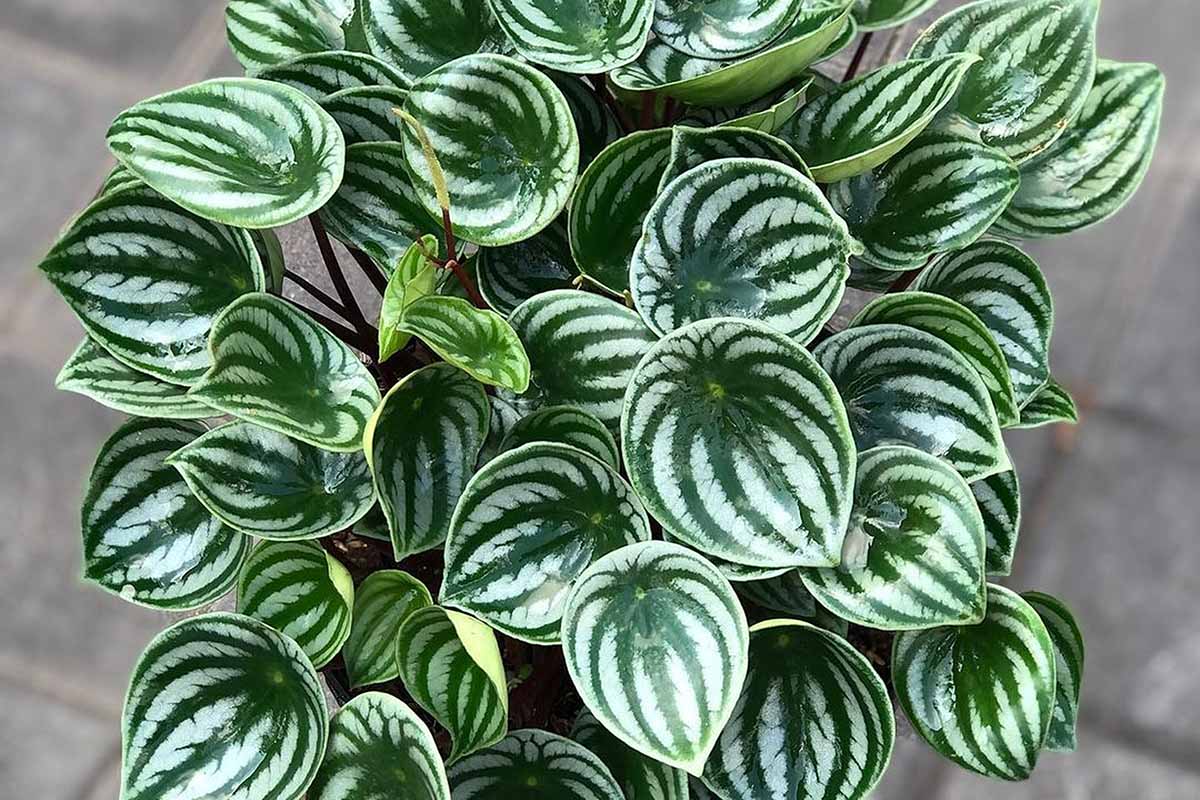
Peperomias thrive in bright, indirect light and need their growing medium to dry out slightly between waterings – the top inch of soil should be allowed to dry.
With small, fine roots, these nontoxic houseplants don’t require frequent repotting and it’s fine to let them get a little rootbound.
Once the potting medium starts to dry out too often, or you check the roots and they are filling up the pot, that’s a good sign that it’s time to repot.
Watermelon peperomia (P. argyreia) is a species of peperomia whose leaves are patterned with stripes reminiscent of those on a watermelon rind.
Do you have a home office or tabletop in need of some peperomia joy?
Purchase live watermelon peperomias in four-inch nursery pots from the California Tropicals Store via Walmart.
Learn more about growing peperomia in our guide.
13. Rex Begonia
The next houseplant on our list, rex begonia, should be allowed to become rootbound to prevent transplant shock from repotting.
With brightly colored foliage, hypnotizing patterns, beguiling leaf shapes, and somewhat fussy care requirements, rex begonias (Begonia x rex-cultorum) are often thought of as divas in the houseplant world.
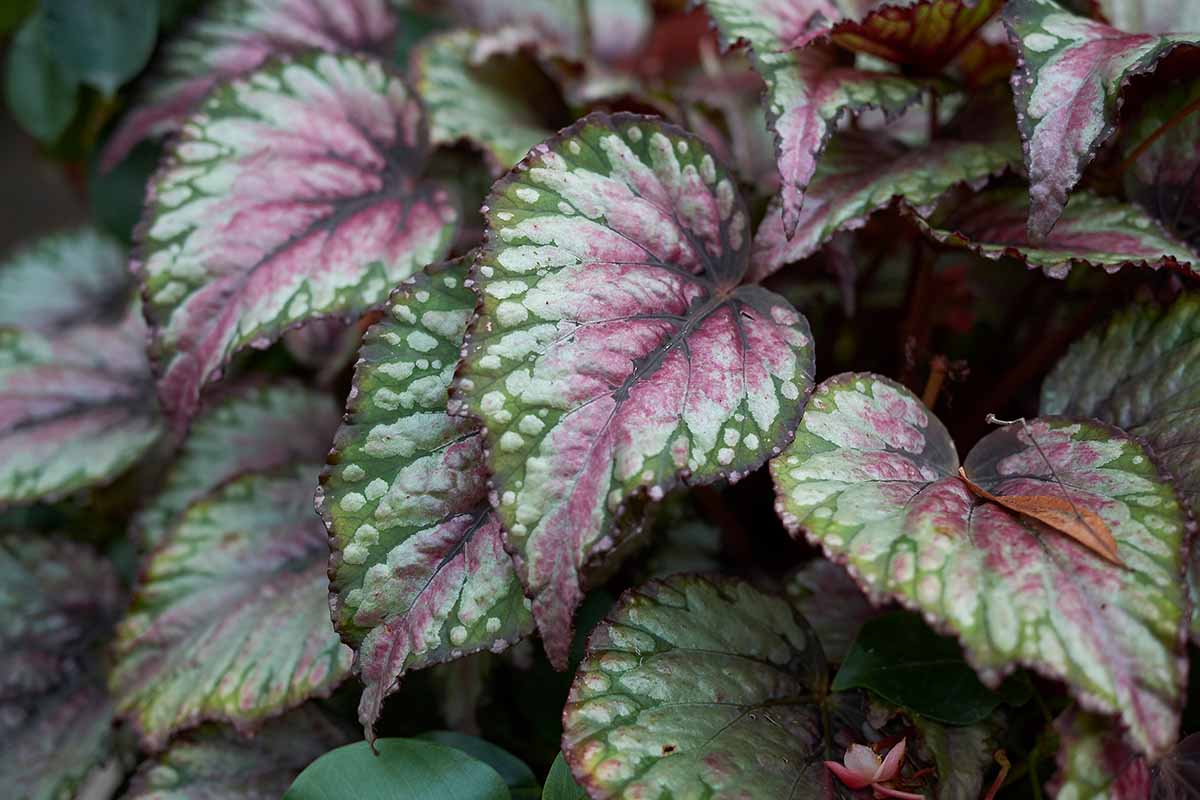
These houseplants need very bright, indirect light and consistently moist soil, accompanied by excellent drainage.
Rex begonias don’t care for being repotted, so they should be allowed to grow in the same container until their roots fill their pot completely.
You can pull a plant out of its container to check for this – if any loose soil remains in the pot when you lift out the plant, it’s not time to repot yet.
Harmony’s ‘Love Potion’ is a cultivar that has green and purple leaves with splatters of white dots.
Ready to bring one of these fascinating rex begonias home?
Harmony’s ‘Love Potion’ Rex Begonia
You’ll find live Harmony’s ‘Love Potion’ rex begonias in six-inch grower’s pots, available for purchase from Florida House Plants via Walmart.
Learn more about growing and caring for rex begonias in our article.
14. Snake Plant
Our next selection, snake plant, benefits from somewhat negligent care, which includes allowing it to become rootbound rather than repotting frequently.
If you want a live houseplant that will put up with being treated as part of the decor, snake plant (Dracaena spp.) makes a great option.

With their long, leathery leaves, snake plants can get by with low light and very little water.
However, growth will be better if they are provided with bright, indirect light. The growing medium should be allowed to dry out almost completely between waterings.
Snake plants make excellent starter houseplants, and when it comes to repotting, they will happily keep growing in the same container until the overgrown roots cause it to crack.
You will need to refresh the growing medium every five years if you don’t repot sooner than that.
What’s better than one snake plant? A grouping of more than one!
Purchase a four-pack of eight-inch tall, live snake plants in 4-inch nursery pots available from Costa Farms via Amazon.
Read our complete guide to growing snake plants for more tips!
15. Spider Plant
This next selection, spider plant, is a resilient, adaptable option that remains happy and healthy when rootbound and infrequently repotted.
Spider plants (Chlorophytum comosum) are perhaps one of the most widely kept houseplants and are easy to recognize – they look like a pot of pale green or green and white grass.

Mature specimens often have spiderettes extending from long thin stems, and they may be the quintessential hanging basket houseplants.
There’s a reason for their popularity – these nontoxic houseplants are supremely easy to care for.
Spider plants can be grown in bright, indirect or medium light and should be allowed to dry out somewhat between waterings. They are fairly adaptable to different watering routines, as long as you don’t overwater.
Growing thick white roots that gradually fill up their pots, there’s no need to repot spider plants until they are bursting out of their containers or until they start drying out too frequently.
In fact, being rootbound will encourage spider plants to produce spiderettes.
‘Ocean’ is a cultivated variety of spider plant that is more compact than the species plant, with leaves reaching eight to 12 inches long at maturity.
Don’t leave this trusty standby of the houseplant world off your wish list – there’s a reason they’re so popular!
You can find live ‘Ocean’ spider plants in six-inch grower’s pots, available for purchase from the California Tropicals Store via Amazon.
Find complete guidance for growing spider plants in our article.
16. Tree Philodendron
This next option on our list, tree philodendron, is best kept somewhat rootbound to keep it from getting too big.
With large, green, lobed leaves, tree philodendron (Thaumatophyllum bipinnatifidum) is a giant of the jungles that will provide a tropical vibe when you bring one into your home.
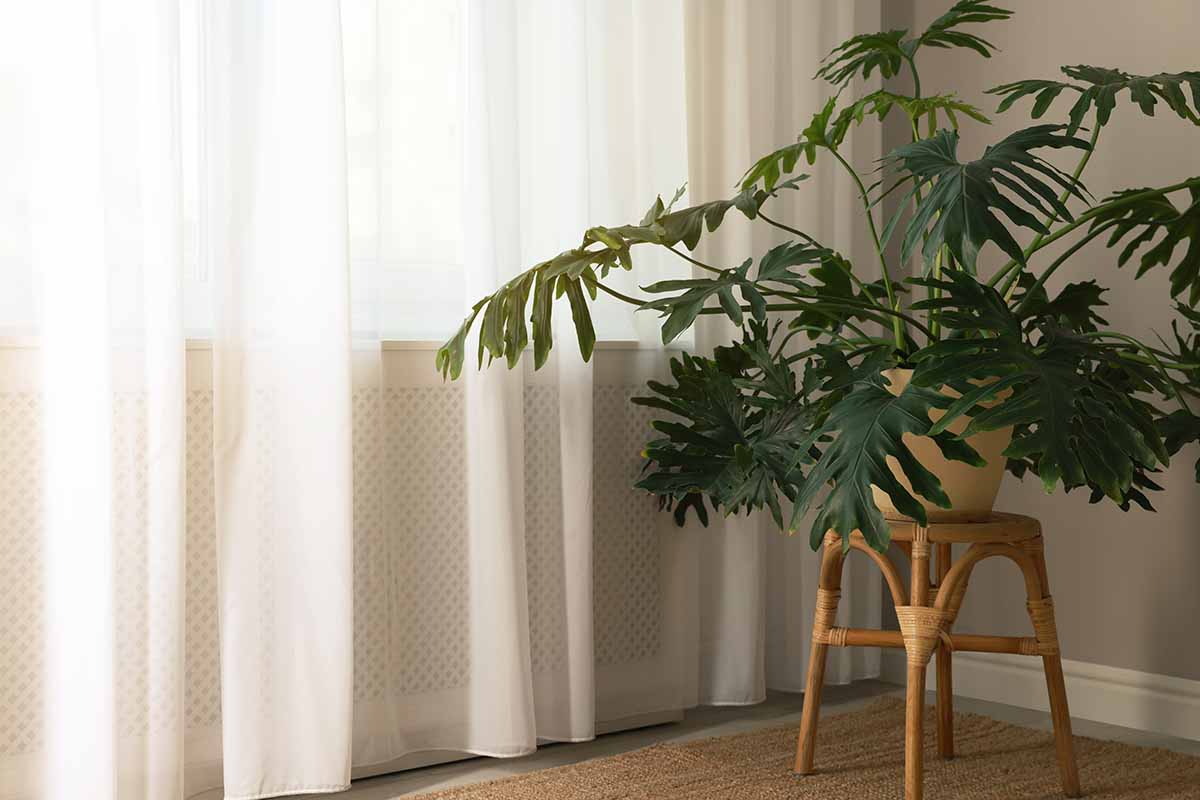
Tree philodendrons thrive in low light to bright, indirect light, and have moderate water needs.
These houseplants thrive with potbound roots, but you’ll need to refresh the potting soil periodically and the roots to keep it in check.
This strategy can prevent the houseplant from outgrowing your home! Learn more about how to repot tree philodendrons in our guide.
Is tree philodendron the missing element you need to complete your indoor jungle?
You can purchase three foot tall and one and a half foot wide, live tree philodendrons in fiber concrete decorative pots from Terrain.
Learn more about how to grow tree philodendrons here.
17. Weeping Fig
Our final selection, weeping fig, is a sensitive option that would rather be rootbound than repotted.
Often appearing with braided trunks or variegated foliage, weeping fig (Ficus benjamina) is another classic houseplant.
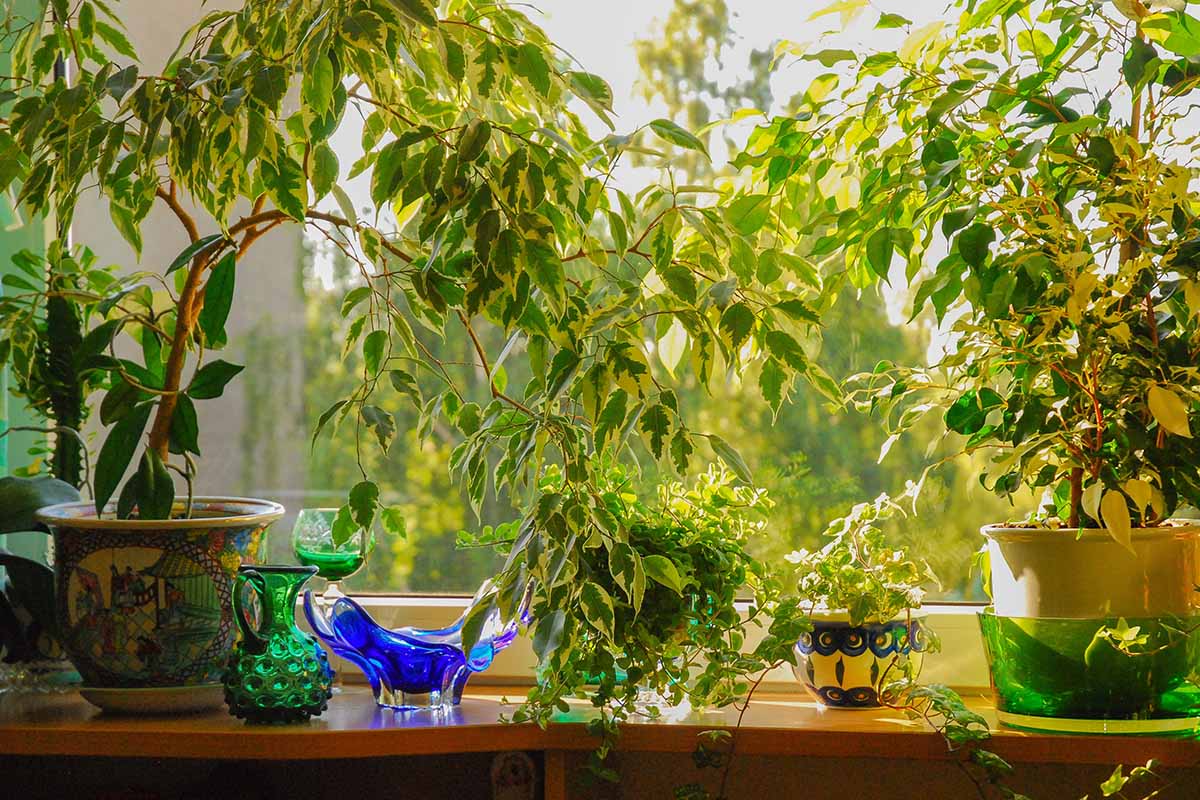
Thriving with bright, indirect sun and moderate watering, weeping figs don’t like changes – and repotting definitely counts as a change!
Weeping figs can be allowed to become rootbound, these shouldn’t be repotted until there are roots coming out of their drainage holes, or circling the surface of the soil.
With their lofty heights and lush foliage, these trees help brighten up corners and soften edges in our homes. Sound like the perfect decorating fix?
Purchase a two- to three-foot or a three- to four-foot, live braided weeping fig tree, with your choice of pot from Fast Growing Trees.
Don’t cry! There’s help for growing and caring for weeping figs right here.
Well-Homed, Happy Houseplants
Once you determine that your houseplant finally needs to be repotted because it is far too rootbound – its roots are emerging from the surface of the soil or the drainage holes, there’s no soil left in the pot, or it’s drying out much too quickly between waterings – here are a few tips to follow:
Water the rootbound specimen first, pot up only one size, and while transplanting, be sure to untangle the outer layer of roots.
Gently tease them away from the root ball – you can do this by rubbing the palm of your hand against the ball of roots. If they are too tightly tangled and you can’t loosen them with your hand, you can rub the tines of a fork along the root ball instead.
Untangling its mass of roots will help them spread into their new potting medium more easily, otherwise they may just remain in a tangled ball and won’t get the benefits of new soil and more room.
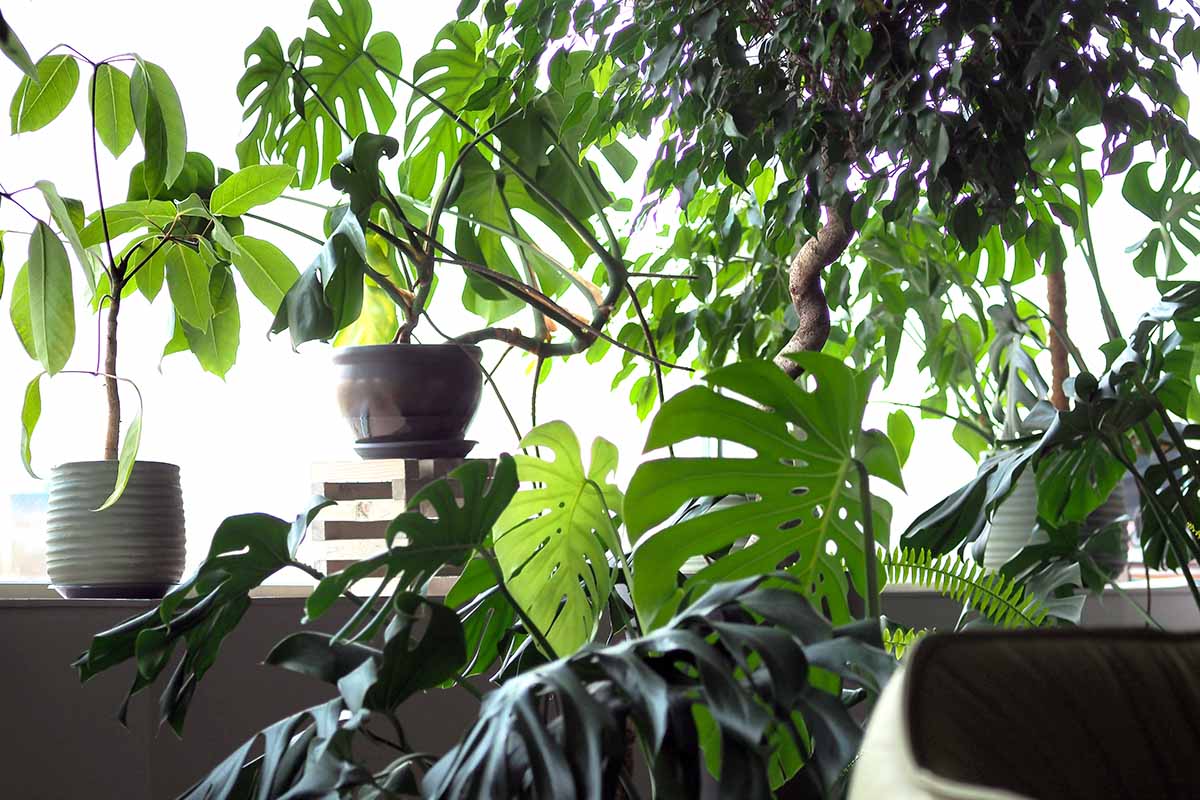
Now that you know which houseplants will be happy living rootbound in their plastic, ceramic, or terra cotta “homes” for long stretches of time, which ones will you pick to add to your own home? Let us know in the comments section below!
Are you wondering if any of your other favorite houseplants will be happy to live a rootbound life too? If so, feel free to pose your questions in the comments section as well.
Want to keep expanding your houseplant knowledge? We have more guides for you right here:
